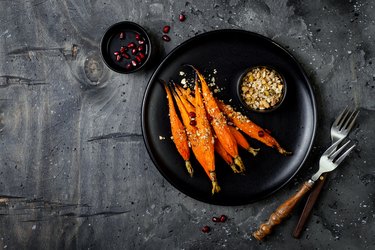
High-protein foods are all the rage for weight loss and muscle building. But some people need to switch to a low-protein diet for kidney disease and other health reasons. If you're among them, fruits and vegetables are the best choice.
List of No-Protein Foods
Video of the Day
There are very few no-protein foods. Most foods contain some amount of protein, even if it's less than a quarter of a gram.
Video of the Day
Meat is highest in protein because this nutrient is an integral component of the muscles, bones and connective tissue in an animal's body. Even the milk they produce is high in protein. Therefore, when you need to reduce your protein intake, you should limit your consumption of animal products.
Plant foods are lower in protein, but some still contain relatively high amounts. For example, beans are a good source of plant-based protein, with about 6 grams in one-half cup of black beans, according to the USDA. Nuts are also a good example, with 6 grams of protein per 1-ounce serving of almonds, for instance.
Grains provide this nutrient too, but in smaller amounts. Brown and white rice have 4 grams of protein per one-half cup, and oatmeal has a little less than 3 grams per one-half cup, cooked. One-half cup of quinoa, which is technically a seed but usually included in the grains group, has 4 grams per half cup.
Most vegetables are fairly low in protein. Carrots, broccoli, tomatoes, cucumbers and asparagus all have between 0.5 and 1.5 grams of this nutrient in a 3.5-ounce serving. The same amount of celery has no protein.
Fruits boast similar protein counts; strawberries, cantaloupe and oranges all have a little less than a gram in a 3.5-ounce portion. A medium apple also contains less than a gram of protein.
Limit Your Protein
You can't live on apples and celery alone, and everyone needs some protein. Your bones, muscles and other body tissues are comprised largely of protein. Without it, your bones and muscles can become weak. According to the National Institutes of Health, older adults who don't get enough protein have an increased risk of bone fractures.
Still, there are good reasons to keep your protein intake in the low to moderate range. If you have kidney disease, for example, the National Kidney Foundation reports that too much protein can strain your kidneys and lead to an increase in urea, a waste product created during protein metabolism. A buildup of urea in the body can lead to fatigue and decreased appetite.
So, how much do you need? The recommended daily intakes for the general population are 46 grams of protein per day for women and 56 grams per day for men, according to the Dietary Guidelines for Americans. Protein needs are determined by age, gender and physical activity level. Your doctor or a certified nutritionist/registered dietitian can help you determine how much you should have in a protein diet for kidney disease.
Low-Protein Cooking Tips
Protein is a highly satiating nutrient, so reducing your intake could cause you to feel less satisfied after meals. The National Kidney Foundation offers some tips on making low-protein meals more satiating:
- Include more low-protein vegetables in your meals. These are high in fiber, which absorbs water in the stomach and slows gastric emptying. As a result, they promote fullness and delay the release of a hunger-stimulating hormone called ghrelin, according to a research review published in the Journal of Nutrition and Metabolism in January 2019.
- Select thinly sliced sandwich meats, which can be spread out to look like a larger portion. Also, choose thin-sliced bread that is lower in protein, such as sourdough or rye.
- Use almond milk instead of soy milk and cow's milk when preparing soups and sauces.
- Make fresh vegetables and grains the focus of your meals; include meat and fish in smaller portions.
- When preparing soups, stews and casseroles, use less meat than the recipe calls for. Add extra vegetables instead.
- Choose strong-flavored cheeses such as blue cheese and sharp cheddar. A little of these cheeses goes a long way.
- USDA: "Black Beans"
- USDA: "Almonds"
- USDA: "Brown Rice"
- USDA: "White Rice"
- USDA: "Oatmeal"
- USDA: "Quinoa"
- Harvard T.H. Chan School of Public Health: "Quinoa"
- USDA: "Tomatoes"
- USDA: "Cucumbers"
- USDA: "Broccoli"
- USDA: "Asparagus"
- USDA: "Carrots"
- USDA: "Celery"
- USDA: "Apples"
- USDA: "Orange, Raw"
- USDA: "Melons, Cantaloupe, Raw"
- USDA: "Strawberries"
- NIH Osteoporosis and Related Bone Diseases National Resource Center: "Once Is Enough: A Guide to Preventing Future Fractures"
- National Kidney Foundation: "Enjoy Your Own Recipes Using Less Protein"
- Health.gov: "Dietary Guidelines for Americans, 2015-2020: Appendix 7. Nutritional Goals for Age-Sex Groups Based on Dietary Reference Intakes and Dietary Guidelines Recommendations"
- Journal of Nutrition and Metabolism: "The Role of Fiber in Energy Balance"